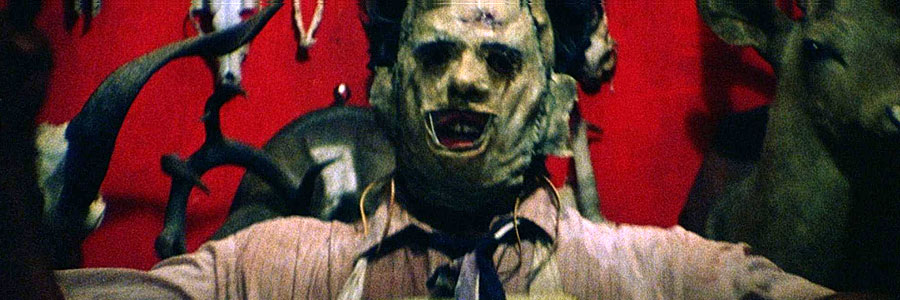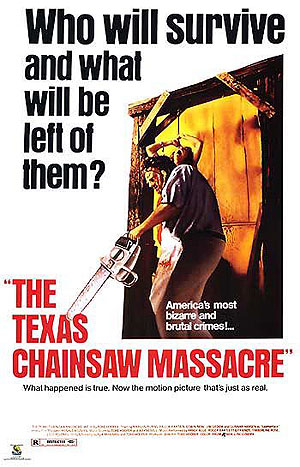
The Texas Chainsaw Massacre
Bryanston Pictures
Original release: October 1st, 1974
Running time: 84 minutes
Director: Tobe Hooper
Writers: Kim Henkel, Tobe Hooper
Cast: Marilyn Burns, Paul A. Partain, Edwin Neal, Jim Siedow, Gunnar Hansen
Kirk and Pam 00:34:45 to 00:40:40
Deconstructing Cinema: One Scene At A Time, the complete series so far

We’ve all heard the saying “A family that plays together, stays together”, but what about a family that slays together? As horrific as the thought might be, I’ve always had a fascination with families like this, who keep their crimes within the confines of their homes and share them with each other. How do the relationships function, if at all, under these circumstances? Whatever family dynamics they have, they’re certainly not healthy ones, but whether its in the news, on television, in a book or film, I’m always curious. Not that I’d ever like to encounter one for myself, but if I ever did, I’d like to understand something about them beforehand – after all, it might be useful in planning a successful escape.
In Tobe Hooper’s 1974 horror shocker, The Texas Chainsaw Massacre, we encounter such a family and witness a series of attempted escapes by the teenagers they hold captive in their house. The film, the first time it’s watched, is distressing in the amount of suffering that’s inflicted on them, as well as the level of depravity the family exist in and live for. Yet for all its unpleasantness, what Hooper presents us with is a film that mirrors one of America’s most gruesome serial killers while at the same time effectively deconstructing its culture and politics in the wake of Vietnam and Watergate.
After opening with a prologue that’s spoken by a narrator, the film begins on August 18th, 1973 with a series of photographic flashes where we glimpse the rotting remains of some poor soul. Over the radio we hear a news report about grave robberies in the Texas area and the discovery of a horribly decomposed body found mounted on a monument like a work of art. While there are no suspects, the police believe the crimes to be committed by someone from outside the area. The camera tracks back and we get a better look at what was left on the monument – it’s a grisly sight. Then, against a blood red backdrop the title of the film appears.

From here we meet Sally (Marilyn Burns), her paraplegic brother, Franklin (Paul A. Partain), their three friends, Jerry (Allen Danziger), Kirk (William Vail), and Pam (Teri McMinn). They’re all travelling in a van to visit Sally and Franklin’s grandfather’s grave to make sure it hasn’t been disturbed following the recent news reports. They spot a hitchhiker, Drayton “Nubbins” Sawyer (Edwin Neal), and decide to pick him up, but after freaking them out with his talk about working in the abattoir, he grabs Franklin’s knife and slashes himself across the palm, then takes out a camera to take a picture of them all. The guy’s obviously mad as a bag of cats but its only when he takes out his own knife and slashes Franklin across the arm that they realise it’s time to throw him out.
Pam, who’s reading a book on American Astrology, notices what it says about Franklin’s horoscope.
Hey, listen to Franklin’s horoscope. “Travel in the country, long-range plans, and upsetting persons around you, could make this a disturbing and unpredictable day. The events in the world are not doing much either to cheer one up.”
JERRY:
That’s just perfect. And now read Sally’s.
PAM:
Oh, no. Capricorn’s ruled by Saturn. “There are moments when we cannot believe that what is happening is really true. Pinch yourself and you may find out that it is.”
Making a stop at a gas station they’re told the pumps are empty so they can’t fill up. The proprietor (Jim Siedow) says he won’t have any until late afternoon so they continue on their way to visit an old family homestead and hope to come back for gas later. Once they get there, Kirk and Pam head off for a swim but instead come across an old house. Kirk goes to ask if they have any gas while Pam waits out front, but after calling out, no one answers. The door, he notices, is unlocked, so he goes inside while continuing to call out. Hearing what can only be described as the sound of pigs nervously grunting, he begins to walk to another room when Leatherface (Gunnar Hansen) steps out, startles him and hits him across the head with a hammer. The sound the impact makes is wet and cracking as his head twists and body falls. Instead of the scene ending we see Kirk’s bloody body violently convulsing on the floor before Leatherface delivers another clumsy blow, pulls his body aside and slides the door shut.
Coming back to the sound Kirk heard which caused him to step further into the house, Raymond W. Gibbs, Jr mentions in The Cambridge Handbook of Metaphor and Thought that this could be one of the many metaphors Hooper employs in the film to layer it with subtext.

What happens to Pam further enforces the idea that these wholesome city kids are just as slaughterable as the pigs, chickens and any other animals Leatherface and his family encounter. After waiting outside and not seeing Kirk come back out, Pam enters the house and what follows is one of cinema’s most horrific moments. She wanders through the hallway and into the darkness, past the room where Kirk was attacked and then stumbles and falls onto a floor covered with chicken feathers and God only knows what else. Looking around she sees a large bone, distinctly human, several teeth, a jaw, the remains of a hand and a couch fashioned out of human skin.
The room of horrors, and much of what we see in the rest of The Texas Chainsaw Massacre was inspired by the real life killer Ed Gein. His crimes also served as the basis for films like Psycho and The Silence Of The Lambs, but here Hooper focuses on the dissociative mania which allowed Gein to meticulously dismember his victims and keep their body parts in jars and strung up in rooms and use their skin to make into masks, outfits and ornaments.
Yet the room of horrors is not the most horrific part of Pam’s time in the house. There’s more to come. As she looks around her in disbelief and disgust, the camera pans a few times on the hen nervously sitting in a cage. Pam begins to vomit and flays about before getting up and trying to leave, she’s now back in the hallway and the door slides open – there’s Leatherface! The big hulky and clumsy creature goes running after her, Pam makes it out the front door but is grabbed from behind by Latherface with both his arms around her, carrying her back inside kicking and screaming like a helpless little animal.
- [1] Raymond W. Gibbs, Jr The Cambridge Handbook of Metaphor and Thought (2008), Cambridge University Press
- [2] Martin Hintz Forgotten Tales of Wisconsin 2010, History Press
Taking her into one of the back rooms, we catch a glimpse of two gleaming meat hooks. We know what’s about to happen but we can’t quite believe it when it does. He lifts her up and onto the hooks, and though we don’t see them piercing her skin, it leaves little to the imagination as the next shot shows us Pam with her eyes closed and screaming in agony as she dangles with her feet off the ground with a bowl beneath her to catch the blood. Next Leatherface powers up his chainsaw and we see Kirk’s lifeless body on a table top waiting to be decapitated. Again, the actions are implied rather than shown, but with the positioning of his body and where the chainsaw is aimed it – it’s clear Kirk’s head is coming off.
The Texas Chainsaw Massacre, with these two murders only halfway through the film, delivers horror in its rawest form. It’s a visceral experience that shocks, nauseates and chills us to the bone in a similar way Marion’s shower scene murder in Psycho and Tina’s death in A Nightmare On Elm Street left us gasping for breath. Whether they happen fast or slow they leave us with the knowledge that these killers won’t show any remorse – their victims are just meat to them. If it’s us in a room with them, or if we end up like Sally who’s later on forced to sit down to dinner with Leatherface, his brother Nubbins and “Grandpa” (John Dugan), it’ll take a lot more than kicking and screaming if we hope to escape. A lot more.

Patrick Samuel
The founder of Static Mass Emporium and one of its Editors in Chief is an emerging artist with a philosophy degree, working primarily with pastels and graphite pencils, but he also enjoys experimenting with water colours, acrylics, glass and oil paints.
Being on the autistic spectrum with Asperger’s Syndrome, he is stimulated by bold, contrasting colours, intricate details, multiple textures, and varying shades of light and dark. Patrick's work extends to sound and video, and when not drawing or painting, he can be found working on projects he shares online with his followers.
Patrick returned to drawing and painting after a prolonged break in December 2016 as part of his daily art therapy, and is now making the transition to being a full-time artist. As a spokesperson for autism awareness, he also gives talks and presentations on the benefits of creative therapy.
Static Mass is where he lives his passion for film and writing about it. A fan of film classics, documentaries and science fiction, Patrick prefers films with an impeccable way of storytelling that reflect on the human condition.
© 2022 STATIC MASS EMPORIUM . All Rights Reserved. Powered by METATEMPUS | creative.timeless.personal. | DISCLAIMER, TERMS & CONDITIONS
HOME | ABOUT | CONTACT | TWITTER | GOOGLE+ | FACEBOOK | TUMBLR | YOUTUBE | RSS FEED
CINEMA REVIEWS | BLU-RAY & DVD | THE EMPORIUM | DOCUMENTARIES | WORLD CINEMA | CULT MOVIES | INDIAN CINEMA | EARLY CINEMA
MOVIE CLASSICS | DECONSTRUCTING CINEMA | SOUNDTRACKS | INTERVIEWS | THE DIRECTOR’S CHAIR | JAPANESE CINEMA





